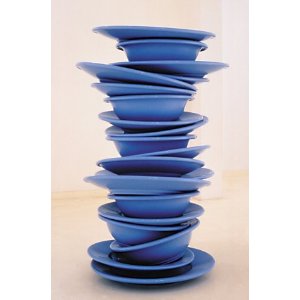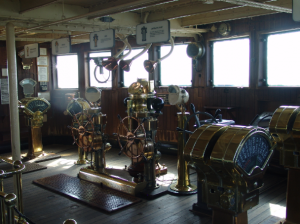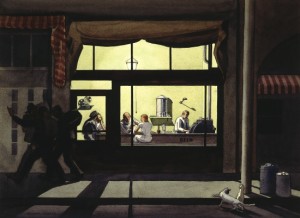What do a giant rock, oversized china and the Queen Mary have in common? Well, they all reside in LA and I recently visited all three when attending my son Oliver’s Pepperdine Law School graduation. Each piece is about art radiating old memories as well as conjuring up new thoughts.

Michael Heizer’s “Levitated Mass” is a 340-ton granite boulder that was trucked from a remote quarry to the Los Angeles County Museum of Art to become permanent outdoor sculpture. This ten million dollar project saw the rock placed on a flatbed and driven 105 miles through city streets, dodging parked cars and overhead utilities to reside over a 456 foot concrete underpass, still in construction. Museum goers will be able to walk under the rock or view the boulder as they enjoy cocktails. I stared at the rock through a chain link fence, observing that it was covered by a green tarp. How ironic, when this massive boulder has sat for millennia in the earth without its jammies. Remember, we are in an era where what the viewer brings to a piece is more important than what the artist intended.
This rock sits outside LACMA’s new expansion designed for large installations. An outside red escalator takes visitors to an observation deck to contemplate LA’s skyline that surrounds the rock. Palm trees, one story storefronts are the immediate backdrop for this boulder with apartment complexes and ranch homes dotting the surrounding hills. Observers can stand before this geological wonder and think about their last encounter with a boulder: the rocks you attempted to climb or the pebbles you removed from your boots when hiking.
Unlike Anish Kapoor’s “Cloud Gate” (2006), in Chicago’s Millennium Park, (affectionately called “the Bean” by Second City-dwellers) this LA rock is all natural but lacks the Bean’s mirror finish allowing passersby to see themselves situated in the reflection of Michigan Avenue buildings—traces of a past when Chicago was the “hog butcher to the world” or Al Capone’s domain.
Inside LACMA is Robert Therrien’s “No Title (Blue Plastic Plates)” (1999). These stacked oversized blue bowls and plates play with scale as they rise almost eight feet. Like the game Jenga, it’s as though one more dish placed on top would topple the collection. Baby Boomers who stand beneath this piece might have memories of Pop Art when everyday objects were blown out of proportion—Claus Oldenberg’s “Spoonbridge and Cherry” (1988) at Minnesota’s Walker Art Center comes to mind. But we are decades from the sixties when artists posed themes about post-war commercialism onto the high end art world. Keep in mind the onlooker’s thoughts are paramount.

Perhaps this dinnerware sans food makes the viewer realize the social divides that exist in urban areas where the homeless push shopping carts in front of luxury sedans. Or think of the many empty bowl projects that feed the hungry nationwide. These faux dishes reside in LA, near Disneyland’s famed teacup ride, an amusement park known for its oversized teacups that take on meanings beyond a Proust tea service. Or maybe those dishes in your sink just need doing.
Another piece full of memories and reinvention is The Queen Mary, permanently moored in Long Beach. Built in 1930 in Clydebank, Scotland, this decommissioned liner was purchased in 1966 to become a hotel and museum. The curious can stroll the decks and imagine spotting the Duke and Duchess of Windsor or climb to the bridge where brass compasses and engine telegraphs stand like sculpture upon teak decks sadly in need of varnish. Gone are the passengers and crew who once bunked in cabins—now tableaux. Worn leather furniture sit in corners where once passengers could instigate an assignation or engage in high finance. Original counterpanes cover beds leaving traces of those who left toiletries or a half read novel, perhaps the only remains of a ship board romance.
The Queen Mary’s Grand Salon serves Sunday Champagne Brunch, a local favorite of Pepperdine Law graduate Kate Vescera who has visited the ship since childhood. Art Deco in its lighting and curly maple paneling, there are murals depicting seabirds and a large map showing the routings of ocean liners (toy ships can be moved as the cruises progressed). This room meant first class dining for celebrities. Today, an actor posing as captain made small talk as the bubbly flowed while we toasted graduates Kate and Oliver, sampling traditional eggs and bacon or for those wishing lunch, a variety of Mexican or Asian fare.
Displays of monogrammed china and period menus with few fresh vegetables, helped today’s guests envision what and how food was served on the ship. A duck press which extracted the juices from the carved carcasses, blended with wine becoming gravy. It was the Depression era, so even luxury liners looked for ways to conserve. After brunch, our party of graduates headed to the engine room where the diesel and lubricating oil can still be smelled. A hole cut into the hull eerily reveals one of the enormous propellers that once drove the Queen across the Atlantic, now home to barnacles and seaweeds. During the war the Queen was painted grey and used to transport soldiers, military hammocks are still found.

Memory and reinvention don’t have to be three dimensional. In LACMA’s gift shop, I found a new book about the late painter Millard Sheets. Many Alaskans have taken watercolor classes from visiting instructors who trained with Sheets, as he is synonymous with California’s watercolor style. Sheets was raised in Pomona and turned down a baseball career to attend Chouinard in Los Angeles, paying for his education by raising rabbits. Using dark blues and browns against strong oranges and mustards, his style reflected the tubular shapes associated with Depression era imagery. In 1932, Sheets became a Chouinard instructor and learned the art of fresco painting from visiting Mexican artist muralist David Siqueiros.
Sheets’ watercolor “Beer for Prosperity” (1933) seems to reflect the various styles of American Regionalism, having been taught by Robert Henri of the Ashcan School or studied the works of Thomas Hart Benton and Grant Wood. “Beer for Prosperity” resembles Edward Hopper’s “Nighthawks” (1942) without the loneliness of a bar after hours. 
The next time you visit LA, go inspect Heizer’s rock or Therrien’s dinnerware at LACMA, or contemplate the complex relationship of the Duke and Duchess of Windsor as you have Sunday brunch where they nightly dined. “Millard Sheets” by Gordon McClelland is available on Amazon.




